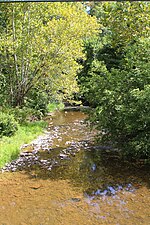Shamokin (village)
1756 disestablishmentsArchaeological sites in PennsylvaniaFormer Native American populated places in the United StatesFormer populated places in PennsylvaniaHistory of Northumberland County, Pennsylvania ... and 8 more
Iroquois populated placesLenapeMoravian Church missionariesMoravian settlement in PennsylvaniaNative American history of PennsylvaniaNative American populated placesPages with non-numeric formatnum argumentsTutelo

Shamokin (; Saponi Algonquian Schahamokink: "place of crawfish") (Lenape: Shahëmokink) was a multi-ethnic Native American trading village on the Susquehanna River, located partially within the limits of the modern cities of Sunbury and Shamokin Dam, Pennsylvania. It should not be confused with present-day Shamokin, Pennsylvania, located to the east. The village was the focus of missionary efforts, and then was the staging area for raids on English settlements in Pennsylvania during the French and Indian War. It was burned and abandoned by the Lenape in May, 1756. A few months later, Fort Augusta was constructed on the site of the village.
Excerpt from the Wikipedia article Shamokin (village) (License: CC BY-SA 3.0, Authors, Images).Shamokin (village)
North 8th Street,
Geographical coordinates (GPS) Address Nearby Places Show on map
Geographical coordinates (GPS)
| Latitude | Longitude |
|---|---|
| N 40.866666666667 ° | E -76.783333333333 ° |
Address
North 8th Street 606
17801
Pennsylvania, United States
Open on Google Maps






